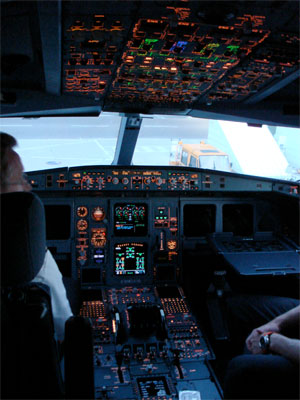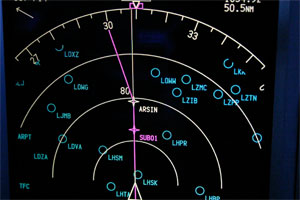About the Author: Catherine Rae T. Ricafort
In the fall of 2005, Catherine Rae T. Ricafort was a junior Industrial Systems Engineering student with a minor in Musical Theatre. During her time at USC, she was a Presidential Scholar and a Merit Research student with Dr. Meshkati.
Runway incursions present a serious danger to airplane passengers today. Any time two planes, or a plane and vehicle, either come close to a collision or actually do collide on the runway surface can be described as an incursion. There are numerous factors that lead to runway incursions, and all of these must be taken into consideration when analyzing and developing technology that can help prevent these disasters.
Introduction
When people think of airplane crashes, they generally imagine a sudden technical malfunction in mid-air, ending with a plummet to the ground. In reality, much of the threat to airplane passengers occurs on the runway itself, before or after the actual flight. For example, in August 2006, 49 people died when a commercial plane crashed into a fence and burst into flames in a field in Lexington, Kentucky [1]. At Los Angeles International Airport in October 2006, two jets on the runway came within 100 feet of colliding with each other [2]. In October 2001, at the Linate Airport in Milan, Italy, two planes crashed into each other, killing 118 people and leaving no survivors [3].
The above incidents are all examples of runway incursions. The Federal Aviation Administration (FAA) defines a runway incursion as an incident where an aircraft (which is taking off or landing) and another aircraft, person, or vehicle on the ground either collide or come dangerously close [4].
Runway incursions have repeatedly topped the National Transportation Safety Board’s list of “Most Wanted” safety improvements for the past decade [5]. These incursions happen frequently and at every airport, creating a major risk for pilots, airport employees, and passengers worldwide. Runway incursions are a serious concern at today’s airports because they can potentially lead to major disasters. In order to decrease the risk of collisions and increase passenger safety, the number of incursions must be significantly reduced.
Causes of Incursions
A large number of factors contribute to runway incursions. Planes and jets are designed to be agile in the air, but they are clumsy and extremely difficult to maneuver on the ground. As aircraft are very large and rather bulky, there is little room for error during the processes of taking off and landing. The cramped and complex configurations of runways and taxi routes at airports make taking off and landing even more difficult. Pilots and ground drivers must ensure that their vehicles are in the right place at the right time while tower controllers coordinate the movements of multiple planes simultaneously (Fig. 1). These human capabilities are often affected by the weather, aviation rules and demands, and stress. Incursions are a particularly difficult problem to solve because of these numerous contributing issues.
The workload and stress on controllers and pilots can greatly affect their ability to consistently make correct decisions on the runway. In the air traffic control tower, controllers must “orchestrate the mix of arriving, departing, and taxiing aircraft as efficiently as possible, in order to avoid aircraft delays and maximize the capacity of the airport” [6]. Controllers continuously analyze raw data from the radar reports, decide on the best paths for different aircraft to take, and relay instructions to pilots in every plane. This becomes increasingly difficult when weather blurs visibility, construction changes the utility of certain pathways, and an airport takes on larger loads of traffic.
The negative effects of increased amounts of work can be seen in the case of Los Angeles International Airport, where controllers claim that “runway construction, which has forced them to funnel all traffic onto the airport’s three other runways, and understaffing in the tower have left them less able to catch blunders by pilots” [2]. During take-off and landing, pilots must manage multiple tasks and perform many checks on the plane while following landing instructions given by the air traffic control. After many consecutive hours of work, alertness in both parties starts to fade and fatigue builds, paving the way for more mistakes to be made.
Faulty communication creates another large source of confusion among pilots and controllers. Radio frequencies are used to communicate instructions to pilots, and to translate location information to air traffic control. These frequencies often become congested due to the high volume of traffic that many airports handle, leading to extremely rapid delivery of crucial commands and data. This leaves barely any time for pilots to ask for clarification, or even confirm that they have received instruction, so mistakes of delivery and interpretation can easily occur [6]. Also, a common technical glitch in radio communication called the Heterodyne Effect occurs when two or more transmissions cancel each other out, causing a prolonged squeal [7]. This phenomenon occurred during the minutes prior to the infamous collision at Tenerife in 1977, blocking out critical transmissions that could have prevented the deadliest accident in aviation history. Finally, communication in an international aviation community becomes even more complicated when pilots who speak different languages cannot easily understand foreign accents over fuzzy radio connections.
Poorly designed airport geometry also contributes to pilot confusion. While all airports have different runway layouts, most consist of a maze of taxiways, parking structures, and runways that often become seriously entangled. For example, at Los Angeles International Airport (LAX), “two sets of parallel runways require pilots who land on an outer runway to cross the inner runway on a series of taxiways” [2]. This frequently-required crossing of runways is a big concern because it often puts taxiing planes into the path of other planes traveling at high velocities for take-off. Many of the incursions that take place at LAX happen because pilots often cross an active runway without the appropriate clearance. Furthermore, pilots who fly all over the world are unfamiliar with the different layouts that they come across, making a poorly designed airport even more dangerous.
Current Systems Used to Aid Runway Safety
Airports currently implement radar systems that guide tower controllers in their coordination of movement in the runway environment (Fig. 2). The FAA has installed these systems, the Airport Movement Area Safety System (AMASS) and its new Airport Surface Detection Equipment-Model X (ASDE-X), at major airports across the United States. These systems show the position and velocity of planes and vehicles within the airport surroundings, and use the detected data to issue warnings and alerts to air traffic controllers. Unfortunately, much of the technology is still faulty and inconsistent.
The detection equipment does two jobs: it detects and displays critical objects in the runway environment, and then analyzes this data to provide warnings of unsafe states [8]. Obtaining the raw data with ground radar systems is difficult because many obstacles exist on the runway surfaces that interfere with the sensors. The systems need to detect the velocities, accelerations, and predicted paths of different vehicles and planes, not just the position. The decision support system in AMASS and ASDE-X takes this trajectory information and predicts whether or not an unsafe state (potential crash) will occur. However, it is difficult to perfect this detection system because it is hard to define exactly what is and is not an unsafe state [8]. For example, would a separation of 100 feet between planes be considered safe, but a separation of 99 feet be considered unsafe? The radar systems take into account data from past likely events and worst-case scenarios to try and address this ambiguity, still leaving an inherent degree of error.
AMASS and ASDE-X issue warnings to controllers, who then decide whether or not to alert pilots to take evasive action. These radar systems often set off false alarms. When setting the parameters for these warnings, the number of false alarms can be reduced by choosing to use less stringent data requirements, but doing so results in an increase of missed targets [8]. While usually better to minimize misses, a high number of false alarms can lead a controller to distrust the system.
Even when a correct alarm sounds, the warning usually does not come early enough to allow for a human response before the incident. At LAX in 2004, an Asiana Airlines Boeing 747 and a Southwest Airlines Boeing 737 almost collided because controllers gave permission for the Southwest plane to cross a runway that was already in use. Although the AMASS system did ring an alarm in the tower “about 10 seconds before the two aircraft would have collided, NTSB (National Transportation Safety Board) simulations show that it would have been too late to make any difference” [9]. Disaster was only narrowly avoided due to the quick maneuvering of the Asiana pilot who saw the impending plane ahead of time.
The 446 passengers in the Asiana / Southwest incident were very lucky to have avoided collision. The reality of what could have happened, however, is so serious that people can no longer depend on such luck and pilot action “bordering on the heroic” in order to avoid collision [10]. Currently, radar systems provide alerts only to the controllers, who must then decide whether or not to warn pilots to take evasive action. But in the dynamic and quickly changing runway environment, every second is crucial in making a safety decision. The time it takes for a controller to judge the danger of a situation and communicate preventive measures to the pilot, coupled with the imperfect and typically late warnings provided by radar systems such as AMASS, leaves no time for a pilot to avoid an impending incursion.
The Future of Incursion Prevention
Considering such runway incidents, the next logical step would be radar systems installed directly into the cockpit in order to increase the pilot’s situational awareness. This way, prevention of incursion does not depend only on the controller, who may be overwhelmed with the management of the entire runway system. With an in-cockpit system, pilots will not be completely left in the dark – they will have information not only on their own position and velocity, but that of other aircraft and ground vehicles so that they can take preventive action on their own. The FAA is now in the process of developing the Automatic Dependent Surveillance-Broadcast (ADS-B), which will provide “both pilots and controllers with enhanced situational awareness of the entire runway environment as well as direct collision warning to the pilot” [10]. However, implementation of ADS-B is not expected until 2014, so AMASS and ASDE-X will have to suffice for now.
The display of information for controllers and pilots can also be greatly improved. For example, LAX controllers currently only see “objects as blobs on a monochromatic screen [that] doesn’t distinguish between a person, a vehicle, or an aircraft” [2]. Improvements to the radar systems currently in progress will colorize the screens so that users can easily differentiate between objects and can make quick and more informed decisions. Also, technology such as the Electronic Moving Map (EMM) is being developed to give the pilot more flexible and easy-to-manipulate data. EMM transmits instructions from air traffic control in both a text and graphic format, and also features removable pop-up windows [11].
An overall effort to reduce incursions can be made by working with the FAA to begin standardizing every aspect of runway safety. With thousands of airports all over the world, pilots must attempt to navigate a different maze every time they fly into a new airport. This confusion can be reduced in several ways. Common layouts of runways/taxiways could be proposed, similar to the uniformity of highway system, which makes it easy to drive anywhere in the country. Uniform signs, lights, and painted markings would help quicken pilots’ responses to directions and understanding of situations [4].
Unvarying modes of communication could also be established, so that data transfer is presented in the same format, and radio voice instructions consist of universal code words. Efforts toward runway safety can even reach down into the educational stage to ensure that pilots learn similar techniques in flight operations. Such improvements can reduce the variability in the runway environment that often currently leads to confusion and dangerous encounters.
Conclusion
A high frequency of runway incursions has posed a major threat to travelers for years, and the problem is difficult to fix because of the complex web of causes. There is no single solution; the goal of reducing the amount of incursions must be approached from all angles by improving radar accuracy, data display, communication methods, and airport layouts. While current radar systems like AMASS have their limitations, new technologies such as the Electronic Moving Map and the Automatic Dependent Surveillance-Broadcast are being developed. The engineering behind runway safety must continue to evolve and focus on the problem of runway incursion so that passengers can fly without the risk of crashing before even taking off.
References
-
- [1] Alan Levin. “Error in Comair Crash Fairly Common. ” USA Today, pp. 3, 28 Aug. 2006.
- [2] Jennifer Oldham. “Crash Narrowly Averted at LAX.” Los Angeles Times., pp. 1, 6 Oct. 2006.
- [3] Anne Paylor. “Taking Aim at Incursions. ” Air Transport World, (30) Sep. 2006.
- [4] Steven Estes, et al. “Better Taxiway Surface Markings, Safer Airports.” Ergonomics in Design. Spring 2005: 13.
- [5] Beth Dickey. “NTSB’s Most Wanted.” Government Executive, vol. 37(1), pp. 30, 2005.
- [6] Dr. Glennis L. Adam and Richard H. Lentz. “Study of the Causes of Runway Incursions and Related Incidents.” First IEEE Conference on Control Applications, pp. 539, 13 Sep. 1992.
- [7] “Plane Crashes.” Most Deadly. The Discovery Channel. Los Angeles. 9 Jan 2007.
- [8] Raja Parasuraman, John Hansman and Steven Bussolari. Framework for Evaluation of Human-System Issues with ASDE-X and Related Surface Safety Systems. Jan 2002.
- [9] Paul Marks. “Urgent Call to End Frequent Runway Near-Misses. ” New Scientist, vol. 188(2519), pp. 22, 2005.
- [10] Frances Fiorino. “NTSB Seeks Multi-Layered Defense Against Runway Incursions.” Aviation Week & Space Technology, vol. 165(20), pp. 40, 2006.
- [11] Denise R. Jones, Cuong C. Quach, and Steven D. Young. “Runway Incursion Prevension System.” NASA: Nov. 2001.
- [12] Arianne Cohen. “Tech Watch: One Wrong Turn.” Popular Mechanics. Internet: http://www.popularmechanics.com/technology/industry/4199546.html, Nov. 2006 [23 Apr. 2007].
- [13] “South Airfield Construction > Airfield Overview. ” LAX Master Plan. Internet: http://www.laxmasterplan.org/soverview.cfm#soverview [23 Apr. 2007].
- [14] “Measures Taken at Los Angeles International Airport (LAX) to Enhance Runway Safety.” LAX Master Plan.Internet: http://www.laxmasterplan.org/pdf/PublicMeetings_AirfieldOperations_20061025.pdf [23 Apr. 2007]




